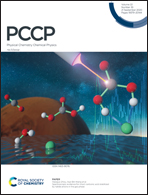The critical role of titanium cation in the enhanced performance of P2-Na0.5Ni0.25Mn0.60Ti0.15O2 cathode material for sodium-ion batteries†
Abstract
Tremendous effort has been devoted to develop durable electrode materials for sodium ion batteries. This work focuses on enhancing the reversibility of a cathode material Na0.5Ni0.25Mn0.75O2 by adopting the titanium cation doping strategy. The obtained P2-Na0.5Ni0.25Mn0.60Ti0.15O2 material shows smooth charge–discharge curves upon suppressing the Na+/vacancy ordering effect via the partial substitution of Mn4+ for Ti4+, and enhanced cycling performance. It exhibits a reversible capacity of 138 mA h g−1 at 0.5C, as well as a high rate capacity of 81 mA h g−1 at 5C between a cut-off voltage of 2 and 4 V, while long-term cycling stability is demonstrated with a capacity retention of 84% over 200 cycles. An enhanced cycling stability is also observed when the voltage is between 2 and 4.2 V. The feasibility of constructing a symmetrical Na-ion full cell with Na0.5Ni0.25Mn0.60Ti0.15O2 as cathode and anode electrodes is also demonstrated. The titanium cation doping results in reduced charge transfer impedance and an enhanced sodium cation diffusion coefficient, thus suggesting an efficient strategy to obtain a durable cathode material for sodium ion batteries.



 Please wait while we load your content...
Please wait while we load your content...